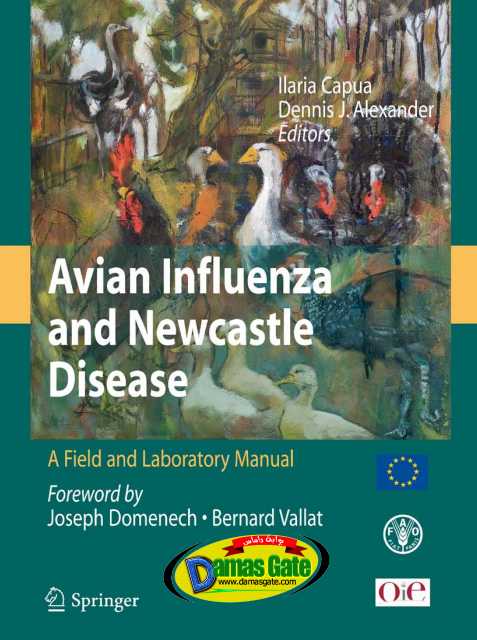Avian Influenza and Newcastle Disease A Field and Laboratory Manual 2009

Preface
In recent times, the worldwide spread of avian influenza (AI) viruses, particularly specific
highly pathogenic AI
viruses of H5N1 subtype, have put the livelihood of small rural poultry
establishments, which historically had been threatened primarily by Newcastle
disease (ND) viruses, at even greater risk. The occurrence of these two infections
on a global scale is
also threatening intensive poultry-farming systems and freerange establishments.
These diseases have several traits in common, including high flock mortality and
certain clinical and pathological findings, and therefore may easily be misdiagnosed
or confused with each other or with other viral or bacterial diseases.
In order to reduce the impact and spread of AI and ND, it is imperative that the
disease is diagnosed properly and that appropriate measures are implemented to contain infection and, ultimately, eradicate
the virus from an infected area. Both diseases have been shown to spread
easily across boundaries and throughout entire continents. Thus, information
on their epidemiology is essential to improve existing guidelines on their control.
This manual was conceived as a result of our efforts in directing international reference laboratories, thus gaining
experience and information from outbreaks in many countries of the world. Our
intention was to provide veterinarians and technicians with a field and laboratory
manual containing all information relevant to the diagnosis and management
of an AI or ND outbreak. In addition we have included information to
support veterinary authorities in management issues.
The Cd-Rom that is included in this publication has been developed to supply trainers
and university teachers with slides and videoclips of field and experimental infections;
this will allow students and trainees to visualize the clinical and pathological
traits of AI and ND. In addition PDF files of protocols and epidemiological inquiry
forms may be downloaded for use.
We are confident that this publication will be useful to the different professions
involved in the farming of birds. Ultimately we are convinced that through improved
communication and diagnosis there will be a greater availability of information essential
for an improved understanding of the ecology, epidemiology and animal and
human health implications of these diseases.
Download
*

Preface
In recent times, the worldwide spread of avian influenza (AI) viruses, particularly specific
highly pathogenic AI
viruses of H5N1 subtype, have put the livelihood of small rural poultry
establishments, which historically had been threatened primarily by Newcastle
disease (ND) viruses, at even greater risk. The occurrence of these two infections
on a global scale is
also threatening intensive poultry-farming systems and freerange establishments.
These diseases have several traits in common, including high flock mortality and
certain clinical and pathological findings, and therefore may easily be misdiagnosed
or confused with each other or with other viral or bacterial diseases.
In order to reduce the impact and spread of AI and ND, it is imperative that the
disease is diagnosed properly and that appropriate measures are implemented to contain infection and, ultimately, eradicate
the virus from an infected area. Both diseases have been shown to spread
easily across boundaries and throughout entire continents. Thus, information
on their epidemiology is essential to improve existing guidelines on their control.
This manual was conceived as a result of our efforts in directing international reference laboratories, thus gaining
experience and information from outbreaks in many countries of the world. Our
intention was to provide veterinarians and technicians with a field and laboratory
manual containing all information relevant to the diagnosis and management
of an AI or ND outbreak. In addition we have included information to
support veterinary authorities in management issues.
The Cd-Rom that is included in this publication has been developed to supply trainers
and university teachers with slides and videoclips of field and experimental infections;
this will allow students and trainees to visualize the clinical and pathological
traits of AI and ND. In addition PDF files of protocols and epidemiological inquiry
forms may be downloaded for use.
We are confident that this publication will be useful to the different professions
involved in the farming of birds. Ultimately we are convinced that through improved
communication and diagnosis there will be a greater availability of information essential
for an improved understanding of the ecology, epidemiology and animal and
human health implications of these diseases.
Download
*